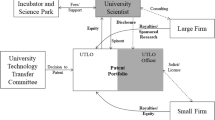Abstract.
This paper examines the role of offices of technology transfer (OTT) in 12 U.S. universities in 1998 in commercializing research results in the form of patents, licenses, and start-ups of new companies. We study the organization and place of OTTs within the university structure, the process of technology transfer, and the staffing and funding of the office. Data were collected through a mail questionnaire followed up through telephone interviews. We also conducted a statistical analysis of data for 170 U.S. universities, hospitals, and research institutes for the period 1991–1996. Our findings suggest that technology transfer from universities to the commercial sector needs to be understood in its broader context. The primary purpose of a technology transfer program is for the university to assist its researchers in disseminating research results for the public good. Success in this endeavor is only partially reflected in income generated for the university or the number of business start-ups. The degree of success depends not only on the nature of the interface between the university and the business community but also on the receptivity in the surrounding community as well as the culture, organization, and incentives within the universities themselves.
Similar content being viewed by others
Author information
Authors and Affiliations
Additional information
Rights and permissions
About this article
Cite this article
Carlsson, B., Fridh, AC. Technology transfer in United States universities. J Evol Econ 12, 199–232 (2002). https://doi.org/10.1007/s00191-002-0105-0
Issue Date:
DOI: https://doi.org/10.1007/s00191-002-0105-0




